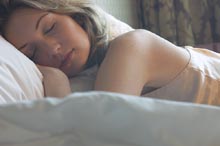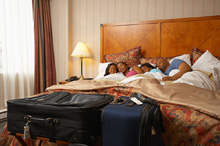Bedbug Infestations Increasing:
What to do if They Show up in YOUR Bed
by www.SixWise.com
Sleep tight, don’t let the bedbugs bite! It’s a tongue-in-cheek rhyme, a catchy, fun phrase to share as you tuck your kids in for bed at night … not one that leaves you feeling itchy and wondering about creepy crawlies lurking under the covers.
|

Bedbugs are easy to spot … if you can find them. They only come out at night to feed and spend the daytime hiding in cracks and crevices of mattresses, furniture and other tight spots.
|
Of course, that might all change now that the biggest bedbug outbreak since World War II is underway across the United States. The resurgence has apartment dwellers, college students, travelers, and others who spend time in mattress-heavy buildings feeling wary, and prompted the U.S. Environmental Protection Agency to hold its first-ever bedbug summit.
Bedbug infestations have become so concerning that a clinical review on the topic was published in the Journal of the American Medical Association (JAMA) just last month, noting that bedbugs are rapidly increasing worldwide.
What are Bedbugs … and Why are They Increasing?
Bed bugs are tiny, six-legged insects that feed on your blood during the night, mostly around 4 a.m. They do so by injecting an anticoagulant that keeps your blood flowing while they suck, along with a numbing agent that keeps you from noticing.
While you could spot a bed bug during this time (they resemble ticks in appearance), during the day bedbugs hide in mattress cords, box springs and in the seams of upholstered furniture. They can even hide in the joints of your wooden bedframe or behind a picture frame, waiting to come out at night to feed.
And since most people don’t notice being bitten at the time, the easiest way to spot a bedbug is the next morning. Bedbug feces that look like tiny black specks may be left on your sheets, along with a small red blood stain.
Bedbug bites themselves typically appear as small, itchy red bumps, which may appear blister-like and swollen.
Fortunately, although there’s speculation that bedbugs may transmit more than 40 human diseases, the JAMA authors reported, “There is little evidence that such transmission has ever occurred.”
More likely, you’ll experience intense itching after being bitten, and one of the greatest risks is scratching your skin and risking infection. In serious cases, allergic reactions including asthma, hives and even anaphylaxis have been reported.
While bedbugs have been around for thousands of years, their incidence is thought to be increasing due to a variety of factors, such as:
-
Increases in international travel (bedbugs travel easily in luggage, clothing, etc.)
-
Insecticide resistance
-
Lack of effective products to eliminate bedbugs, including health concerns about spraying mattresses with pesticides
|
Itchy Skin? Insect Bites? Quret!

Quret's Drawing Salve is an all-natural formula that has been safely and effectively providing long-term relief for nearly any skin eruption -- since 1918. Treating skin boils is Quret's most popular usage, but it's also extremely effective for:
-
Insect bites/stings
-
Minor cuts/scrapes
-
Ingrown toenails
-
Splinters
-
Papercuts
Learn more about Quret's Drawing Salve now!
|
Can Bedbugs be Prevented?
Bedbugs can show up anywhere but there are several factors that increase your risk:
-
Living in a tropical area: Bedbugs thrive in warm climates, although they can be found in any region.
-
Visiting or living in a building with a high turnover rate: Apartment buildings, college dormitories, homeless shelters and hotels are more likely to harbor bedbugs than single-family homes.
-
Pets: Bedbugs can enter your home and bedding via your cat or dog.
Because of this, we highly suggest you use the top-recommended Flea 'n Tick B Gone, which is completely non-toxic, pesticide-free and safe. It can be sprayed directly onto your dog or cat to effectively repel bedbugs, along with fleas, ticks and other pests.
Experts also advise against picking up discarded mattresses, sofas, clothing or upholstered furniture, or getting them at a garage sale or resale shop. If you do purchase clothes at a resale shop, wash them as soon as possible in very hot water, then dry them on high, or have them dry cleaned.
If you’re traveling, you should always check the hotel sheets for rust-colored stains, which may be a sign of bedbugs. If you notice them, switch hotels before spending the night or unpacking your luggage -- or at the very least change rooms. We also recommend carrying a small bottle of Flea ‘n Tick B Gone with you and spraying your mattress before you get into bed.
What to do if Your Bed is Infested
The first sign that you’ve got bedbugs will likely be an itchy, red rash. If you suspect anything at all, check your home for other signs of infestation, which include:
|

After returning home from a hotel stay, inspect your luggage carefully to make sure there are not unwanted visitors.
|
-
Small bloodstains on your sheets and mattresses
-
Specks of blood behind loose wallpaper or other areas (behind picture frames, etc.)
-
Insect excrement on your sheets or at the entry of common hiding places like furniture crevices and walls
-
A sweet odor, which is caused by bedbugs’ oil secretions
If you find bedbugs, you’re likely going to need to hire a professional to help with the removal. This can include encasing your mattress in box spring in special covers, high-suctioning vacuuming, heat or steam treatments, and pesticides (although these are not recommended for use on bedding or mattresses). Another effective option is to place infested furniture outdoors in the sun for several days or in the cold of winter for two weeks. The extreme temperatures, coupled with no food source, causes bedbugs to die.
You can also try misting your mattress and other hiding spots (walls, furniture seams, etc.) with Flea 'n Tick B Gone, which will kill bedbugs on contact yet is all-natural, making it entirely safe for you and your family.
While you’re removing the bugs from your home, sleeping in long pajamas will help ward off bites. And to help soothe itchy bites, try a natural anti-itch cream like Porter’s Liniment Salve or Quret Drawing Salv. Both will help to eliminate itching and promote faster healing of your skin, using all-natural, gentle ingredients.
Recommended Reading
Just How Germ-Infested are the Hotel Rooms You Stay In? What are the Risks?
Bugs that Bite: Interesting Facts & Necessary Precautions on the Insects That Crave You
Sources
Journal of the American Medical Association April 1, 2009;301(13):1358-1366
MayoClinic.com Bedbugs
NYTimes.com April 14, 2009
Yahoo News May 15, 2009